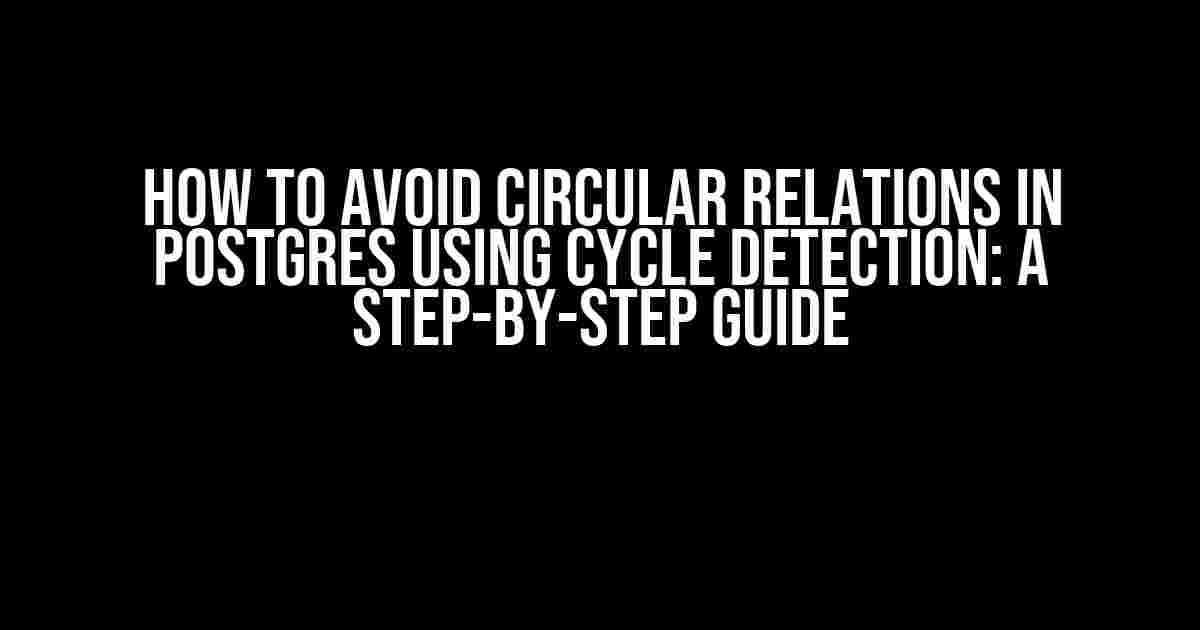Are you tired of dealing with circular references in your Postgres database? Do you find yourself going around in circles trying to resolve these pesky relationships? Fear not, dear reader, for we have some excellent news for you! In this article, we’ll show you how to avoid circular relations in Postgres using cycle detection, and take your database management skills to the next level.
What are Circular Relations, and Why are They a Problem?
Circular relations, also known as circular dependencies or cycles, occur when two or more tables in a database reference each other directly or indirectly. This creates a loop where data is dependent on itself, making it difficult to manage and maintain. Circular relations can lead to:
- Data inconsistencies and errors
- Slow query performance
- Increased complexity in database design
- Difficulty in scaling and maintaining the database
The Importance of Cycle Detection in Postgres
Cycle detection is a technique used to identify and prevent circular relations in a database. In Postgres, cycle detection is crucial to ensure data integrity and maintain a well-designed database. By detecting cycles, you can:
- Avoid data inconsistencies and errors
- Improve query performance and efficiency
- Simplify database design and maintenance
- Scale your database with confidence
How to Detect Cycles in Postgres
Postgres provides several methods to detect cycles, including:
1. Using the `pg_depend` System View
The `pg_depend` system view provides information about dependencies between database objects. You can use this view to detect cycles by querying for dependencies between tables.
SELECT * FROM pg_depend
WHERE refclassid = 'pg_class'::regclass
AND refobjid IN (SELECT oid FROM pg_class WHERE relname = 'table_name')
AND deptype = 'n';
2. Using the `pg_rewrite` System View
The `pg_rewrite` system view provides information about rewrite rules in the database. You can use this view to detect cycles by querying for rewrite rules that reference the same table.
SELECT * FROM pg_rewrite
WHERE rulename = 'rule_name'
AND ev_class = 'pg_class'::regclass
AND ev_objid IN (SELECT oid FROM pg_class WHERE relname = 'table_name');
3. Using a Cycle Detection Algorithm
A cycle detection algorithm can be implemented using a depth-first search (DFS) or breadth-first search (BFS) approach. These algorithms traverse the graph of dependencies between tables to identify cycles.
CREATE OR REPLACE FUNCTION detect_cycles()
RETURNS SETOF text AS $$
DECLARE
visited RECORD;
stack RECORD;
cycle text;
BEGIN
FOR visited IN SELECT * FROM pg_class
LOOP
IF NOT EXISTS (SELECT 1 FROM pg_depend WHERE refobjid = visited.oid AND deptype = 'n') THEN
CONTINUE;
END IF;
stack := visited;
WHILE stack IS NOT NULL LOOP
IF stack.oid = visited.oid THEN
RAISE EXCEPTION 'Cycle detected: %', cycle;
END IF;
cycle := cycle || ' -> ' || stack.relname;
stack := (SELECT * FROM pg_depend WHERE refobjid = stack.oid AND deptype = 'n');
END LOOP;
END LOOP;
RETURN;
END;
$$ LANGUAGE plpgsql;
How to Avoid Circular Relations in Postgres
Now that we’ve covered how to detect cycles, let’s focus on how to avoid them in the first place. Here are some best practices to follow:
1. Use a Hierarchical Database Design
A hierarchical database design involves organizing tables into a tree-like structure, where each table has a single parent table. This design helps to avoid circular references and makes it easier to manage dependencies.
| Table Name | Parent Table |
|---|---|
| Orders | Customers |
| Order Items | Orders |
| Products | NULL |
2. Use Bridge Tables
Bridge tables, also known as intersection tables, are used to resolve many-to-many relationships between tables. By using bridge tables, you can avoid circular references and simplify your database design.
| Table Name | Column 1 | Column 2 |
|---|---|---|
| Customers | Customer ID | NULL |
| Orders | Order ID | Customer ID |
| Order Items | Order Item ID | Order ID |
| Products | Product ID | NULL |
| Order Items Products | Order Item ID | Product ID |
3. Use Views and Materialized Views
Views and materialized views can help to simplify complex queries and reduce dependencies between tables. By using views, you can avoid circular references and make your database design more modular.
CREATE VIEW orders_with_products AS
SELECT o.order_id, o.customer_id, p.product_id, p.product_name
FROM orders o
JOIN order_items oi ON o.order_id = oi.order_id
JOIN products p ON oi.product_id = p.product_id;
Conclusion
In conclusion, avoiding circular relations in Postgres using cycle detection is crucial for maintaining a well-designed and efficient database. By using the techniques and best practices outlined in this article, you can detect and prevent cycles, ensuring data integrity and scalability. Remember, a little planning and attention to detail can go a long way in avoiding circular relations and making your database management life easier!
So, the next time you’re faced with a circular reference, don’t panic! Just follow the steps outlined in this article, and you’ll be well on your way to detecting and preventing cycles in your Postgres database.
Here are 5 Questions and Answers about “How to avoid circular relations in Postgres using cycle detection”:
Frequently Asked Question
Having trouble with circular relations in your Postgres database? We’ve got you covered!
What is a circular relation in Postgres?
A circular relation in Postgres occurs when multiple tables are related to each other in a way that forms a loop, making it difficult to maintain data consistency. For example, if table A has a foreign key referencing table B, and table B has a foreign key referencing table A, you’ve got a circular relation on your hands!
Why are circular relations bad?
Circular relations can lead to data inconsistencies, errors, and even crashes! They can also make it challenging to perform queries, backups, and database maintenance. So, it’s essential to detect and avoid them in your Postgres database.
How do I detect circular relations in Postgres?
One way to detect circular relations is by using the `pg_depend` system catalog in Postgres. This catalog stores dependency information between database objects, including foreign key relationships. You can write a query to traverse the dependency graph and identify cycles. Alternatively, you can use tools like `pggraph` or `postgres_fdw` to visualize your database schema and spot circular relations.
How can I avoid circular relations in Postgres?
To avoid circular relations, design your database schema with a clear understanding of the relationships between tables. Use a top-down approach to model your data, and aim for a hierarchical structure. Additionally, use constraints like PRIMARY KEY, UNIQUE, and FOREIGN KEY to ensure data consistency and prevent cycles from forming. Finally, regularly review and refactor your schema to ensure it remains cycle-free.
What tools can help me with cycle detection in Postgres?
There are several tools available to help with cycle detection in Postgres. Some popular ones include `pgbadger`, `pg_stat_statements`, and `pg_top`. These tools can help you identify performance bottlenecks, query optimization opportunities, and even cycles in your database schema. Additionally, you can use GUI tools like `pgAdmin` or `DBeaver` to visualize your database schema and spot circular relations.






